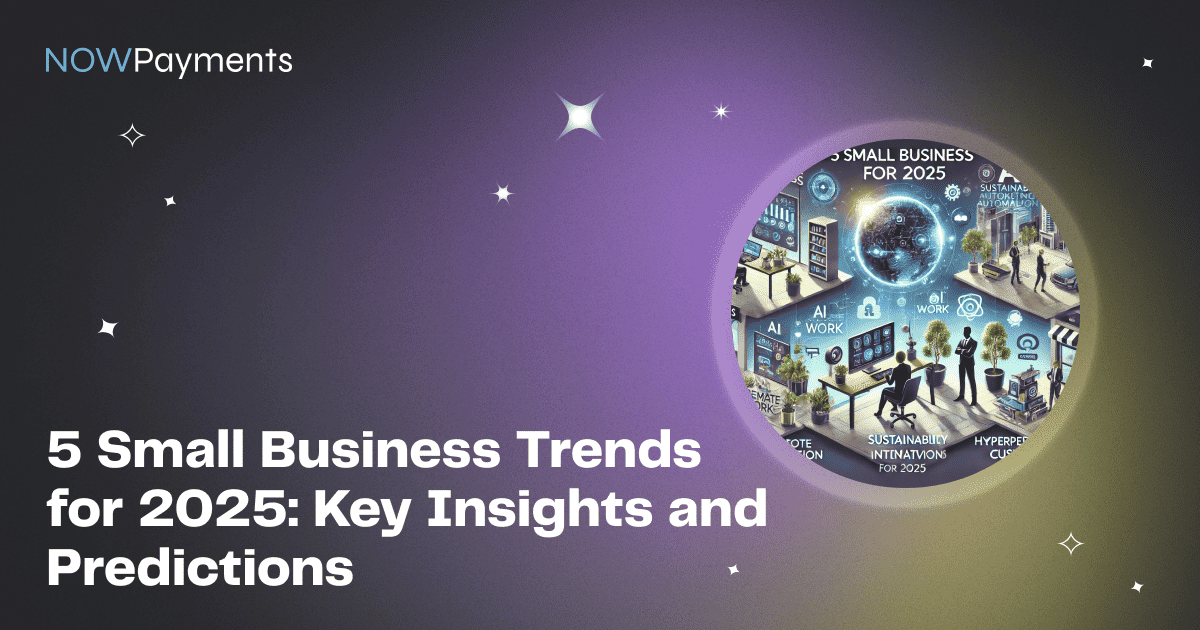As we move into 2025, businesses are rapidly adapting to new technological advancements, shifting consumer expectations, and evolving market dynamics. From AI integration and sustainability efforts to remote work models and hyperpersonalization, companies are embracing innovations that enhance efficiency, drive customer engagement, and ensure long-term success. With digital payments becoming a crucial part of this transformation, platforms like NOWPayments are at the forefront, enabling businesses to integrate seamless and cost-effective cryptocurrency transactions. Understanding these key trends will help organizations stay competitive and agile in an ever-changing landscape.
AI integration
Business leaders are increasingly turning to AI integration as a key strategy for 2024 and beyond. The rise of generative ai is set to transform business operations and reshape the customer experience, with small business owners prioritizing automation and analytics to improve productivity. As we approach 2025, business trends to watch include the increasing use of AI-powered chatbots and digital solutions that can help small businesses optimize their e-commerce strategies and enhance their supply chain management.
In the coming year, business leaders say that leveraging artificial intelligence will be essential for business administration and cybersecurity. Trends that will shape the future of work include the need for seamless digital transformation, with a focus on business trends for 2025 that emphasize efficiency and adaptability. Consumers say they’re willing to engage with AI-driven solutions, driving small business trends that capitalize on these advancements. As we look to 2026, the integration of AI will redefine how business leaders approach their business ideas and strategies.
Sustainability and circular economy
As we move toward 2025 and beyond, the focus on sustainability and the circular economy is becoming a top priority for business trends to know. The pandemic has accelerated a shift toward more sustainable practices, prompting many top businesses to optimize their operations. Companies are leveraging AI and machine learning to streamline processes, reduce production costs, and enhance their environmental impact.
Following these emerging trends, businesses can tap into new opportunities to foster customer loyalty. Studies show that consumers now say they’re willing to pay more for sustainable products. IoT technologies and AI chatbots are also expected to grow, providing a strategic advantage for companies that stay ahead in this evolving work environment. As a result, a thriving business model will be one that embraces these changes and prioritizes sustainability in its core strategy.
Remote and hybrid work models
In 2023, the shift towards remote and hybrid work models has accelerated, fueled by emerging technologies and the increasing adoption of large language models. Companies are leveraging AI to help businesses streamline processes and make smarter decisions, following the key trends of the past five years. This work trend not only enhances human resource management but also allows organizations to gain a competitive edge in a rapidly evolving business world.
As we look towards 2025, the growth in 2025 promises even greater optimization of work from home practices, as companies will continue to adapt to geopolitical changes. The integration of social media platforms and technologies like virtual collaboration tools will shape trends shaping 2025. While brick-and-mortar operations remain essential, the new business models will focus on creating a sustainable business framework that prioritizes flexibility and employee well-being.
Remote and hybrid work models
As organizations adapt to new working environments, remote and hybrid work models are becoming increasingly popular. Global leaders are now ready to tackle challenges posed by the US-China trade war and rising interest rates could impact how businesses operate. These models have the potential to surpass traditional in-office setups, allowing companies to leverage AI and digital tools to enhance productivity.
Following trends in workforce dynamics, businesses are focusing on last-mile delivery solutions to improve efficiency in their products or services. The Inflation Reduction Act has further incentivized organizations to innovate and incorporate AI into their operations, with remote work expected to account for a significant portion of the labor market in the coming years.
Customer hyperpersonalization
Customer hyperpersonalization refers to the practice of tailoring products, services, and experiences to individual customers’ preferences and behaviors. By leveraging advanced technologies, businesses can create highly customized interactions that resonate with each consumer.
To achieve this level of personalization, companies often use AI to analyze vast amounts of data, identifying patterns and insights that inform their strategies.
The integration of AI allows for real-time adjustments, ensuring that marketing messages and recommendations are relevant and timely.
Ultimately, hyperpersonalization enhances customer satisfaction and loyalty, paving the way for stronger relationships between brands and their consumers.
Business hyperautomation and insights generation
Business hyperautomation refers to the use of advanced technologies, including artificial intelligence and robotic process automation, to automate complex business processes beyond traditional automation. This approach not only streamlines operations but also enhances productivity and efficiency across various functions.
One of the key benefits of hyperautomation is its role in insights generation. By leveraging data analytics and machine learning, organizations can uncover valuable insights from their operations, customer interactions, and market trends. This data-driven decision-making enables businesses to respond swiftly to changing conditions and optimize strategies for better outcomes.
Ultimately, hyperautomation and insights generation work in tandem to drive innovation, reduce costs, and improve overall performance, positioning companies to thrive in today’s dynamic business environment.
Conclusion
The future of business is being shaped by AI-driven automation, sustainable practices, and enhanced digital interactions. As businesses refine their strategies to keep up with evolving trends, leveraging innovative solutions will be essential for growth. The adoption of hyperautomation, customer personalization, and remote work models highlights the shift toward a more flexible and efficient corporate environment. In this fast-changing world, integrating smart payment solutions, such as those offered by NOWPayments, ensures that businesses remain adaptable and prepared for the next wave of digital transformation. Staying ahead of these trends will not only optimize operations but also create new opportunities for long-term success.

